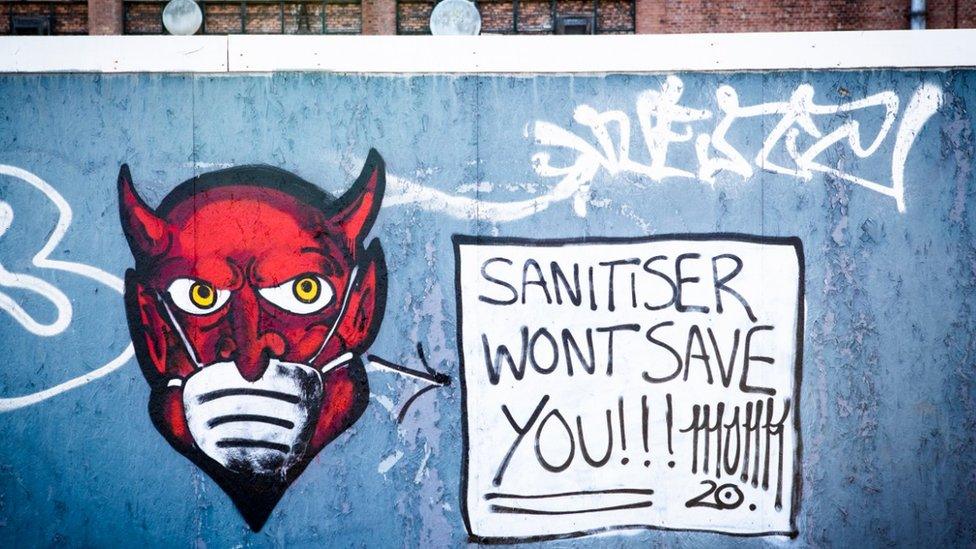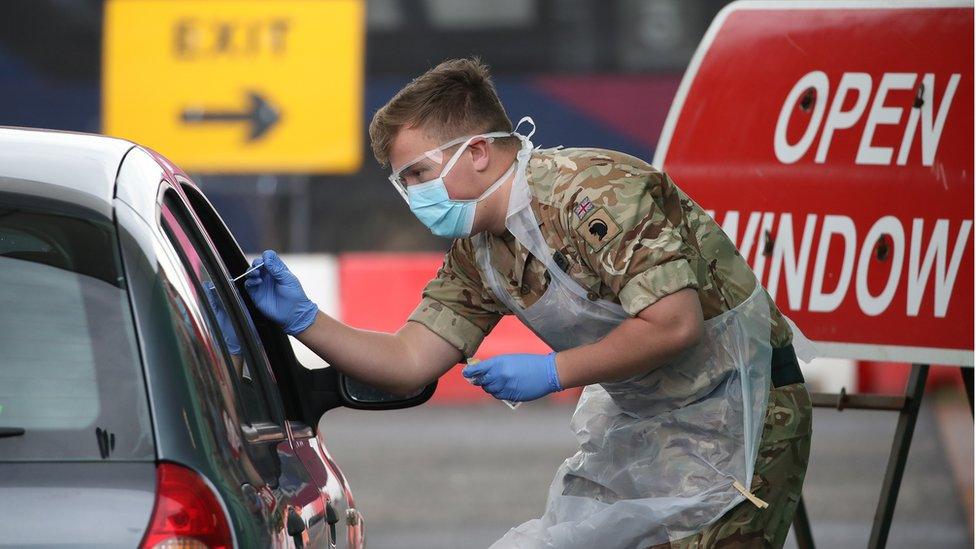Coronavirus in Scotland: What we don't know about the outbreak
- Published

The daily government briefings have delivered an avalanche of statistics about the coronavirus outbreak in Scotland.
But there are a number of questions about the pandemic which remain unanswered.
How many people have been infected?
It is a very difficult question to answer given the vast majority of people with Covid-19 seem to have mild or no symptoms.
But back at the start of the pandemic such estimates were more forthcoming.
In March, the former chief medical officer Dr Catherine Calderwood said each death represented up to 1,000 potential cases and each intensive care patient could represent another 500 cases.
The Scottish government says these figures are no longer valid, adding that it is now "difficult to estimate with certainty how many people have had the virus and recovered beyond the daily numbers we publish".

Testing centres, such as this one run run by the army at Glasgow Airport, have been set up across the country as part of the bid to tackle coronavirus
So how do they know what is going on? The original Scottish government plan to assess the spread of the new virus was to piggyback on the well-established GP "sentinel" surveillance system for the winter flu, which is run through 200 GP practices and covers a population of 1.2 million.
This approach was then dropped in favour of Health Protection Scotland (HPS) using a sample of the people presenting with moderate symptoms at Covid-19 community hubs and assessment centres.
When asked what was happening with this monitoring, the Scottish government said HPS was in "the process of ramping up surveillance testing", with a spokesman adding that "additional surveillance testing is being undertaken at a community level to monitor and manage the spread and prevalence of coronavirus".
The most tangible pointer for infections comes in the form of data from NHS24, which has received nearly 60,000 calls during the lockdown from people worried they had coronavirus, with just over 40,000 of these consultations resulting in a caller being referred to a doctor for further assessment.
In terms of "live" cases of infections - that is those who currently have the virus and have not yet recovered - the Scottish government estimate stands at about 26,000, external, a number which it says is "much too high to consider the virus under control".
Why are more people dying from other causes?
One of the most alarming trends of the pandemic has been the spike in so-called "excess" deaths, as laid out in the graph below.
The data shows that there have been 3,752 more deaths in the past four weeks than would be expected, based on a five-year average.
To put these "extra" deaths is some context, this is about the same number of people killed on Scotland's roads in the past 15 years.
While the majority of these were linked to coronavirus - marked in red on the chart - concerns have been raised about "excess" deaths due to other causes.

This has included situations where people have put off going to hospital, such as heart disease or stroke patients, but also indirect coronavirus deaths such as suicide or drugs overdose.
A full understanding of the excess deaths will take some time to become clear.
It is likely to be the case that, given the age and health profile of those dying, the virus has brought forward some deaths which would have been spread over the course of a year.
How is coronavirus affecting the poorest and most vulnerable?
We know that people living in more deprived areas of England and Wales are more likely to die with coronavirus than those in more affluent places.
Mortality rates are normally higher in poorer areas but Office for National Statistics analysis shows there were 55 deaths for every 100,000 people in the most deprived parts of England, compared with 25 in the wealthiest areas.
The same data used to work this out is also captured north of the border - but a similar analysis has not been carried out yet. The National Records of Scotland (NRS) said it is keeping this under review.
One indicator that Scotland will be in line with the trends elsewhere in the UK is that the country's most deprived council area, Inverclyde, has the highest death rate.

In addition, figures shown to councillors in Fife suggested that, of the 73 people who had died there with coronavirus by 16 April, 23% were from parts of Fife with the highest levels of deprivation and 15% were from the least deprived areas.
What about people from ethnic minorities?
The stark message from England and Wales is that black men and women are nearly twice as likely to die with coronavirus as white people.
The Office for National Statistics analysis shows the inequality persists after taking into account age, where people live and some measures of deprivation and prior health.
And previous BBC News analysis found that 84 of the 135 healthcare workers whose deaths have been publicly announced were from ethnic minority backgrounds.

Large numbers of NHS staff come from an ethnic minority background
However, equivalent data for the impact on coronavirus on people with an ethnic minority background is not currently available in Scotland.
This is largely because collection of ethnicity data is undertaken on a voluntary basis and "unlike the rest of the death registration process, are not statutory".
A NRS spokeswoman said the public body does not believe that the ethnicity data that has been submitted so far is "at an acceptable level of quality to produce robust statistics for these purposes".
This may be because the numbers affected are too low.


Use the form below to send us your questions and we could be in touch.
In some cases your question will be published, displaying your name, age and location as you provide it, unless you state otherwise. Your contact details will never be published. Please ensure you have read the terms and conditions.
If you are reading this page on the BBC News app, you will need to visit the mobile version of the BBC website to submit your question on this topic.